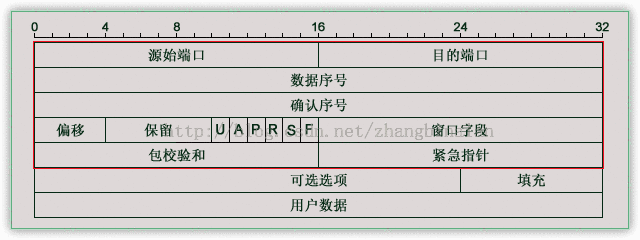TCP报文格式
TCP报文格式:
固定首部长度为20字节,可变部分0~40字节,各字段解释:
- 源端口,16bits,范围0~65525。
- 目的端口,16bits,范围同上。
- sequence number: 数据序号,32bits,TCP 连接中传送的数据流中的每一个字节都编上一个序号。序号字段的值则指的是本报文段所发送的数据的第一个字节的序号。
- acknoledgement number: 确认号,32bits,期望收到对方的下一个报文段的数据的第一个字节的序号。
- 数据偏移,4bits,单位为4字节,它指出报文数据距TCP报头的起始处有多远(TCP报文头长度)。
- 保留字段 6bits,保留今后使用,目前置0处理。
URG:紧急比特,1bit,当 URG=1 时,表明紧急指针字段有效。它告诉系统此报文段中有紧急数据,应尽快传送(相当于高优先级的数据)
ACK:确认比特,1bit,只有当 ACK=1时确认号字段才有效。当 ACK=0 时,确认号无效
PSH:推送比特,1bit,接收方 TCP 收到推送比特置1的报文段,就尽快地交付给接收应用进程,而不再等到整个缓存都填满了后再向上交付
RST:复位比特,1bit,当RST=1时,表明TCP连接中出现严重差错(如由于主机崩溃或其他原因),必须释放连接,然后再重新建立运输连接
SYN:同步比特,1bit,同步比特 SYN 置为 1,就表示这是一个连接请求或连接接受报文
FIN:终止比特,1bit,用来释放一个连接。当FIN=1 时,表明此报文段的发送端的数据已发送完毕,并要求释放运输连接
窗口大小,16bits,窗口字段用来控制对方发送的数据量,单位为字节。TCP 连接的一端根据设置的缓存空间大小确定自己的接收窗口大小,然后通知对方以确定对方的发送窗口的上限。
检验和,16bits,检验和字段检验的范围包括首部和数据这两部分。在计算检验和时,要在 TCP 报文段的前面加上 12 字节的伪首部。
紧急指针字段,16bits,紧急指针指出在本报文段中的紧急数据的最后一个字节的序号。
选项字段,长度可变。TCP首部可以有多达40字节的可选信息,用于把附加信息传递给终点,或用来对齐其它选项。 这部分最多包含40字节,因为TCP头部最长是60字节(其中还包含前面讨论的20字节的固定部分)
选项的第一个字段kind说明选项的类型。有的TCP选项没有后面两个字段,仅包含1字节的kind字段。第二个字段length(如果有的话)指定该选项的总长度,该长度包括kind字段和length字段占据的2字节。第三个字段info(如果有的话)是选项的具体信息. kind=0是选项表结束选项
kind=1是空操作(nop)选项,没有特殊含义,一般用于将TCP选项的总长度填充为4字节的整数倍
kind=2是最大报文段长度选项,TCP连接初始化时,通信双方使用该选项来协商最大报文段长度(Max Segment Size,MSS)。TCP模块通常将MSS设置为(MTU-40)字节(减掉的这40字节包括20字节的TCP头部和20字节的IP头部)。这样携带TCP报文段的IP数据报的长度就不会超过MTU(假设TCP头部和IP头部都不包含选项字段,并且这也是一般情况),从而避免本机发生IP分片。对以太网而言,MSS值是1460(1500-40)字节。

Source port (16 bits)
Identifies the sending port
Destination port (16 bits)
Identifies the receiving port
Sequence number (32 bits)
Has a dual role:
If the SYN flag is set (1), then this is the initial sequence number. The sequence number of the actual first data byte and the acknowledged number in the corresponding ACK are then this sequence number plus 1.
If the SYN flag is clear (0), then this is the accumulated sequence number of the first data byte of this segment for the current session.
Acknowledgment number (32 bits)
If the ACK flag is set then the value of this field is the next sequence number that the sender is expecting. This acknowledges receipt of all prior bytes (if any). The first ACK sent by each end acknowledges the other end's initial sequence number itself, but no data.
Data offset (4 bits)
Specifies the size of the TCP header in 32-bit words. The minimum size header is 5 words and the maximum is 15 words thus giving the minimum size of 20 bytes and maximum of 60 bytes, allowing for up to 40 bytes of options in the header. This field gets its name from the fact that it is also the offset from the start of the TCP segment to the actual data.
Reserved (3 bits)
For future use and should be set to zero
Flags (9 bits) (aka Control bits)
Contains 9 1-bit flags
NS (1 bit): ECN-nonce concealment protection (experimental: see RFC 3540).
CWR (1 bit): Congestion Window Reduced (CWR) flag is set by the sending host to indicate that it received a TCP segment with the ECE flag set and had responded in congestion control mechanism (added to header by RFC 3168).
ECE (1 bit): ECN-Echo has a dual role, depending on the value of the SYN flag. It indicates:
If the SYN flag is set (1), that the TCP peer is ECN capable.
If the SYN flag is clear (0), that a packet with Congestion Experienced flag set (ECN=11) in IP header was received during normal transmission (added to header by RFC 3168). This serves as an indication of network congestion (or impending congestion) to the TCP sender.
URG (1 bit): indicates that the Urgent pointer field is significant
ACK (1 bit): indicates that the Acknowledgment field is significant. All packets after the initial SYN packet sent by the client should have this flag set.
PSH (1 bit): Push function. Asks to push the buffered data to the receiving application.
RST (1 bit): Reset the connection
SYN (1 bit): Synchronize sequence numbers. Only the first packet sent from each end should have this flag set. Some other flags and fields change meaning based on this flag, and some are only valid for when it is set, and others when it is clear.
FIN (1 bit): Last package from sender.
Window size (16 bits)
The size of the receive window, which specifies the number of window size units (by default, bytes) (beyond the segment identified by the sequence number in the acknowledgment field) that the sender of this segment is currently willing to receive (see Flow control and Window Scaling)
Checksum (16 bits)
The 16-bit checksum field is used for error-checking of the header, the Payload and a Pseudo-Header. The Pseudo-Header consist of the Source IP Address, the Destination IP Address, the protocol number for the TCP-Protocol (0x0006) and the length of the TCP-Headers including Payload (in Bytes).
Urgent pointer (16 bits)
if the URG flag is set, then this 16-bit field is an offset from the sequence number indicating the last urgent data byte
Options (Variable 0–320 bits, divisible by 32)